

Making Literacy Part of Every Day in Child Care
by Elaine Weitzman
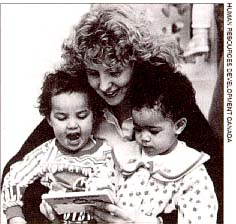 Child care providers play a critical role in facilitating the early development of literacy. The term
"emergent literacy" provides a new perspective on early reading and writing, and involves
developmental learning, which is individual and self-regulated. Child care providers promote
emergent literacy when they use the printed word in real-life, purposeful situations. These situations
will have a powerful impact on children's acquisition of literacy if they:
Child care providers play a critical role in facilitating the early development of literacy. The term
"emergent literacy" provides a new perspective on early reading and writing, and involves
developmental learning, which is individual and self-regulated. Child care providers promote
emergent literacy when they use the printed word in real-life, purposeful situations. These situations
will have a powerful impact on children's acquisition of literacy if they:
Create a Cozy, Well-Stocked Book Centre
Book centres are a crucial part of an environment that promotes emergent literacy. However, not all book centres are user-friendly!
Children will use the book centre if:
Children Need Opportunities to Experiment with Writing
Children know that writing involves making marks on paper and they do this early on. They progress from random scribbling, to controlled scribbling, to naming their scribbles, to writing mock letters and words and, finally, to writing real letters and words. This is a process of discovery, which can be encouraged in a natural way by providing children with many opportunities for drawing, scribbling and writing. The following materials encourage scribbling and writing for a variety of purposes:
Make Print Talk in Your Child Care Environment
To get children interested in print, they need to see that print, in fact, "talks." This can be done by using and demonstrating the use of the printed word during everyday interactions. When children see adults using print, they ask, "What does this say?" becoming eager to experiment with both reading and writing.
Child care is a wonderful place for children to learn about the printed word: it offers so many good reasons to use print and so many people to share it with. But print in the environment has to be accessible to children. Posters on the wall above children's eye level have little effect. We know that children learn best when they can see, touch and experiment with materials -- and the same applies to materials that promote the development of literacy. So keep environmental print at the children's eye level, where they can gather round it, point at and talk about it.
Using Print During Daily Routines and Activities
Adults use print as part of their everyday lives, and so should children. In child care there are many different purposes for using print.
Use signs to communicate rules and instructions and to provide labels. Just as there are "No Parking" and "Entrance" signs in the real world, put up signs that relate to your daily routines and activities at the children's eye level!
Ideas for signs:

Encourage children to write their names on their artwork and respond to their attempts to write
their "names," even when you can't read them.
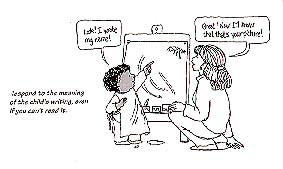
Let the children help you find coupons for the groceries and supplies you buy for the centre. Show them the items you need and give them supermarket flyers to page through. This is lots of fun and a good lesson in budget planning!
Lists have an important purpose in life (if you can find them when you need them!), and children should be exposed to them early on. Show children how you use lists to remind you which groceries to buy or which supplies to replace. Keep your lists in visible places and let the children help you make them up, even if it means drawing the articles you need to buy. You can then write the word next to the picture.
Using Print for Pleasure and Social Interaction
Help children experience the pleasure that comes from using print and the opportunities it provides for social interaction.
Making books
Books are great fun to make and read together, especially when the children are the topic of the
book and when their photographs are used as illustrations. So get out your camera and take pictures
of the children on an outing, during Hallowe'en, at your Christmas party or engaging in their
activities on a normal day. Then, together with the children, make a book, letting
them tell you what to write. Place the finished product in the book
centre and watch how often they "read" their book.
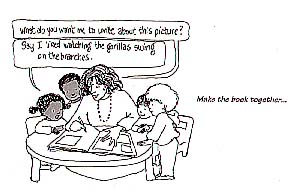
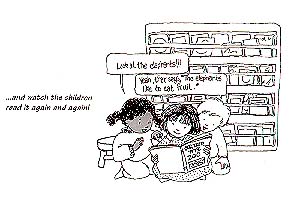
Children should also be encouraged to make up their own stories. Provide blank books and let them know that you are available if they want to dictate a story to you. Encourage them to write their own stories. Reassure them that their writing doesn't have to look like an adult's and encourage them to use invented spelling, which involves spelling words the way they hear them. Spelling, like language, develops according to a predictable sequence.
For example, look how a child's spelling of the word "train" changes over time:
Beginning invented spellers may start off with only one letter per word (and it may not even be the right letter!), but with practice and exposure, their spelling will change and develop. If children ask you how to spell a word, ask them what sounds they can hear in the word, and encourage them to write these down (they tend to ignore the vowels, which is very normal). If you do spell a word for them, write it on a piece of paper while you spell it out loud. Seeing the whole word is probably easier for a young child than listening to the letters being spelled one at a time.
Encourage children to illustrate their books, and then put the books in the book centre -- after all, these books are written by budding authors.
Rules and instructions
Let the children see how reading is necessary for some pleasurable activities like playing a game with rules, a computer game or for assembling a toy. Let them see you read the instructions and point to the print as you read it.
Using print for dramatic play
Children will incorporate the use of print into their dramatic play -- if you provide the necessary
materials. Every dramatic play area should have pads of paper and pencils available. When the
dramatic play area is a store, a bank or a post office, the children will enjoy activities such as
labelling objects, writing prices on groceries, making bank deposit slips and addressing letters.
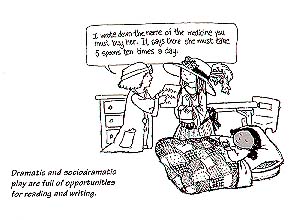
Using Print to Communicate with Others
It's exciting to write a letter or a card and to have someone read and appreciate it. It's also exciting to receive mail from someone else.
Letters and greeting cards to friends and family
Although you always make materials available to the children who enjoy writing letters and cards,
card-making can be a special activity around Valentine's Day, Christmas Day, Mother's and
Father's Day and friends' birthdays.
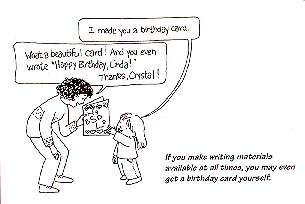
Letters of thanks and invitation
Letters of invitation to special guests or letters of thanks are also good ways of getting children involved in using print to communicate with others. Let each child contribute to a letter written on a large sheet of paper. They can either dictate their messages or write them themselves.
From time to time, write personal letters to parents, telling them something that happened to their child that day (e.g. that their child made an interesting construction with Lego or enjoyed a new book). Discuss with the child why you are writing the letter and let him help you compose it. Make him feel important in his role as "letter carrier."
Use Print to Record Information
Show children how print enables us to record and remember information. Record things on charts at the children's eye level!
Birthdays
Put up a list of the children's names and birthdays so they can point to them and compare dates and years. You could either list them or group them according to month. You can make this chart with the children, letting them tell you their birth dates and, if they can, letting them write their names. This kind of chart is useful only when it is at children's eye level.
Announcements
Watch children rush in and try to read your announcement, especially if their name is on it! Announcements are exciting and interesting -- use them often!
Chloe has a new baby sister!
Welcome back Eric!
Songs and Poems
Happy Birthday to you,
Happy Birthday to you,
Happy Birthday dear Cindy,
Happy Birthday to you.
A well-known song encourages children to point to the words and "read" them. Introduce these charts at group or circle time and let the children read along with you. Then paste them on the wall at the children's eye level. By "reading" these charts to themselves, children begin to figure out where words begin and end, and which letters make which sounds. Soon they will start to recognize some words.
Open-ended bulletin boards and suggestion boards
Your bulletin boards can be left blank -- let the children fill them in with their own artwork, letters, stories and signs.
Have a suggestion board where children can write or draw any ideas they have for activities, outings, rules, menu items, etc. And try to act on their suggestions when possible.
You can also create bulletin boards or charts related to a theme or to a story you have read with the children. For example, if you have read "The Very Hungry Caterpillar," you could have a bulletin board that says "The Very Hungry Children in Kindergarten: Look at what they ate through!" Each child could draw or write in some of the things she or he ate, and if necessary, you could write the word underneath. Interactive bulletin boards are a lot of fun, but they are only valuable when you talk about them with the children and when they see you write down their ideas.
Group Stories
The children can make up a story as a group, and then dictate it to you. You write the story onto a large piece of paper as they dictate. Read aloud what you are writing as you write. For maximum effectiveness, read the written story as a group while you point to the words, moving your finger smoothly across the lines. Because they are so familiar with the story, the children will feel as if they are actually reading (after all, they made the story up!). When this activity is over, hang the story on a board or wall and the children will read and reread it to themselves.
Use Print to Gain Information and Knowledge
Children need exposure to print as a means of learning about new and interesting things.
Newspapers, magazines, flyers
Show children newspaper articles with large, interesting pictures and read the article aloud. Make sure the topic is interesting and adapt the language to the children's level.
Maps
Maps are fascinating for children, especially if they identify places of personal interest, such as where the children now live and where they or others used to live.
Place a map of the world permanently at the children's eye level and refer to it to find places mentioned in books, places where people go on vacation, places in the news, and so on.
Conclusion
Literacy is no longer viewed as a skill that children learn when they begin primary school. We now know that literacy begins at birth and is dependent upon children's exposure to and interactions with the printed word, with appropriate models and input from encouraging adults. If children come to view print as a powerful form of communication, they will soon reach the following all-important conclusions:
What I do or see or hear or touch, I can talk about.
What I talk about, I can write about or someone can write for me.
What is written down, I can read or someone can read for me.
This is the foundation for becoming literate -- and child care providers play a critical role in establishing the foundations of early literacy.
Note: The ideas provided in this article are appropriate for children aged two to six, although some are appropriate only for older children. It is best to follow the children's lead when deciding which activities to use. For example, when children are at the scribbling stage, it is best not to push them to write, but it is appropriate to model writing for them in purposeful activities. This article is based on a chapter from Elaine's Weitzman's book Learning Language and Loving It: A Guide to Promoting Children's Social and Language Development in Early Childhood Settings, which is available from The Hanen Centre, 252 Bloor Street West, Suite 3-390, Toronto, Ontario M5S 1V5. Tel: (416) 921-1073; FAX (416) 921-1225.
Elaine Weitzman, M.Ed., is a speech language pathologist and executive director of The Hanen
Centre, an internationally-recognized organization committed to providing support and training in
language facilitation to parents, caregivers and teachers of young children.
Cambourne, B. (1988). The Whole Story: Natural Learning and the Acquisition of Literacy in
the Classroom. Auckland, New Zealand: Ashton Scholastic.
Carle, E. (1981). The Very Hungry Caterpillar. New York: Scholastic.
Chafel, J.A. (1982). "Making Early Literacy a Natural Happening." Childhood
Education, May/June, 300-304.
Cochrane-Smith, M. (1984). The Making of a Reader. Norwood, NJ: Ablex.
Forester, A.D. & Reinhard, M. (1989). The Learners Way. Winnipeg: Peguis.
Goodman, K. & Goodman, Y. (1983). "Reading and Writing Relationships: Pragmatic Functions."
Language Arts, 60 (5), 590-599.
Goodman, K. (1986b). What's Whole in Whole Language? Richmond Hill, Ontario:
Scholastic.
Goodman, Y. (1984). "The Development of Initial Literacy." In H. Goelman, A. Oberg & F.
Smith, (Eds.), Awakening to Literacy (pp. 102-109). Exeter, NH: Heinemann.
Graves, D. & Stuart, V. (1986). Write from the Start: Tapping your Child's Natural Writing
Ability. New York: Plume.
Holdaway, D. (1979). The Foundations of Literacy. Sydney, Australia: Ashton
Scholastic.
Jewell, M.G. & Zintz, M.V. (1986). Learning to Read Naturally. Dubuque: Kendall
Hunt.
Kimmel, M.M. & Segel, E. (1983). For Reading out Loud. New York: Delacorte
Press.
Lamme, L.L. (1984). Growing up Writing. Washington, D.C.: Acropolis Books Ltd.
Loughlin, C.E. & Martin, M.D. (1987). Supporting Literacy: Developing Effective Learning
Environments. New York: Teachers College Press.
Miller, S.A. (1991). "Whole Language: It's an Experience!" Scholastic Pre-K Today,
January Issue, 44-72.
Strickland, D. & Morrow, L.M. (Eds). (1989). Emerging Literacy: Young Children Learning
to Read and Write. Newark, DE: International Reading Association.
Taylor, D. (1983). Family Literacy: Young Children Learning to Read and Write.
Exeter, NH: Heinemann.
Teale, W.H. & Sulzby, E. (Eds.), (1985). Emergent Literacy: Writing and Reading.
Norwood, NJ: Ablex Publishing Corporation.
Temple, C.A., Nathan, R.G. & Burris, N.A. (1982). The Beginnings of Writing.
Boston, Mass: Allyn and Bacon.
References
|
This article first appeared in Interaction published by the Canadian Child Care Federation, Spring, 1995. |

|
|
 |  |  |